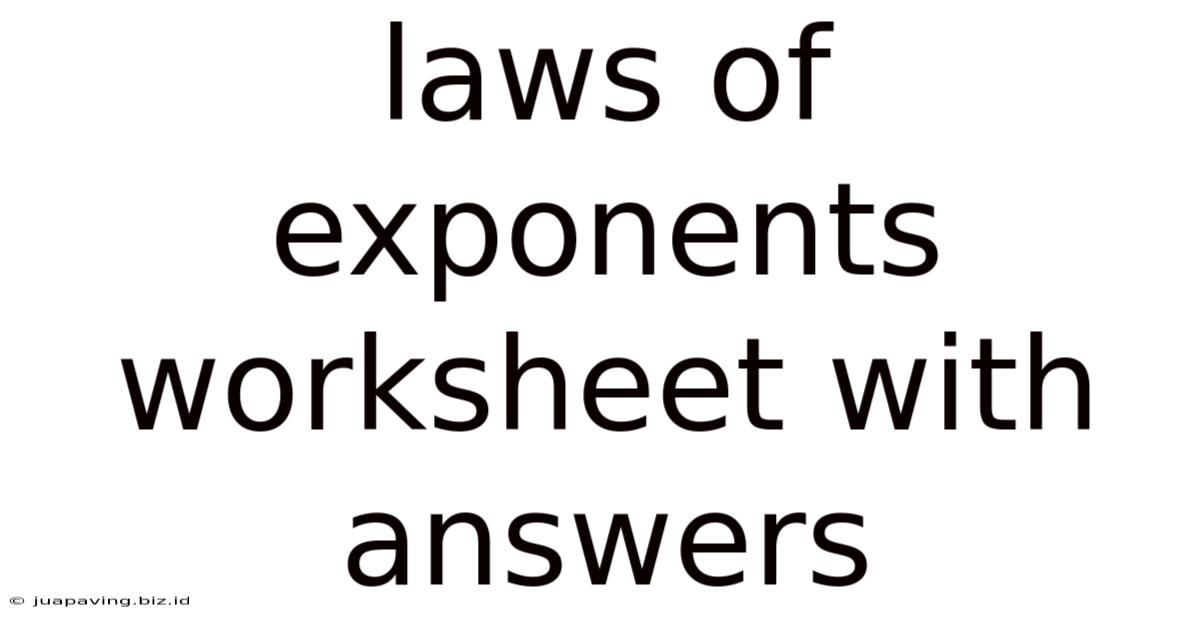Laws Of Exponents Worksheet With Answers
Juapaving
May 10, 2025 · 4 min read

Table of Contents
Laws of Exponents Worksheet with Answers: A Comprehensive Guide
Understanding the laws of exponents is crucial for success in algebra and beyond. This comprehensive guide provides a thorough explanation of these laws, accompanied by a worksheet with detailed answers to help you master this fundamental mathematical concept. We'll cover each law individually, providing examples and clarifying common misconceptions. By the end, you'll be confident in applying these rules to simplify and solve various exponential expressions.
What are Exponents?
Before diving into the laws, let's establish a firm understanding of what exponents are. An exponent, also known as a power or index, indicates how many times a base number is multiplied by itself. For example, in the expression 5³, 5 is the base and 3 is the exponent. This means 5 multiplied by itself three times: 5 x 5 x 5 = 125.
The Fundamental Laws of Exponents
There are several key laws governing how exponents behave. Let's explore each one with illustrative examples:
1. Product of Powers Rule: a<sup>m</sup> * a<sup>n</sup> = a<sup>m+n</sup>
This rule states that when multiplying two exponential expressions with the same base, you add the exponents.
Example:
- 2³ * 2² = 2<sup>(3+2)</sup> = 2⁵ = 32
- x⁴ * x⁵ = x<sup>(4+5)</sup> = x⁹
2. Quotient of Powers Rule: a<sup>m</sup> / a<sup>n</sup> = a<sup>m-n</sup>
This rule dictates that when dividing two exponential expressions with the same base, you subtract the exponents.
Example:
- 3⁵ / 3² = 3<sup>(5-2)</sup> = 3³ = 27
- y⁷ / y³ = y<sup>(7-3)</sup> = y⁴
Important Note: The base must be the same for both the product and quotient rules to apply. You cannot directly combine exponents with different bases. For instance, 2³ * 3² cannot be simplified using these rules.
3. Power of a Power Rule: (a<sup>m</sup>)<sup>n</sup> = a<sup>m*n</sup>
This rule explains how to handle exponents raised to another power. You multiply the exponents.
Example:
- (2²)³ = 2<sup>(2*3)</sup> = 2⁶ = 64
- (x⁵)² = x<sup>(5*2)</sup> = x¹⁰
4. Power of a Product Rule: (ab)<sup>m</sup> = a<sup>m</sup>b<sup>m</sup>
When a product is raised to a power, each factor within the parentheses is raised to that power.
Example:
- (2x)³ = 2³ * x³ = 8x³
- (3xy)² = 3² * x² * y² = 9x²y²
5. Power of a Quotient Rule: (a/b)<sup>m</sup> = a<sup>m</sup>/b<sup>m</sup> (where b ≠ 0)
Similar to the power of a product rule, when a quotient is raised to a power, both the numerator and denominator are raised to that power.
Example:
- (x/y)⁴ = x⁴/y⁴
- (2/3)² = 2²/3² = 4/9
6. Zero Exponent Rule: a⁰ = 1 (where a ≠ 0)
Any non-zero base raised to the power of zero equals 1.
Example:
- 5⁰ = 1
- x⁰ = 1 (assuming x ≠ 0)
7. Negative Exponent Rule: a<sup>-m</sup> = 1/a<sup>m</sup> (where a ≠ 0)
A negative exponent signifies the reciprocal of the base raised to the positive exponent.
Example:
- 2⁻³ = 1/2³ = 1/8
- x⁻² = 1/x²
Common Mistakes to Avoid
Several common errors arise when working with exponents. Be mindful of these pitfalls:
- Incorrectly adding or subtracting exponents with different bases: Remember, the product and quotient rules only apply to expressions with the same base.
- Forgetting to apply exponents to all terms within parentheses: Ensure that all factors inside parentheses are raised to the given power.
- Misinterpreting negative exponents: Remember that a negative exponent does not make the expression negative; it indicates a reciprocal.
- Incorrectly multiplying exponents in power of a power: Remember that you multiply the exponents, not add them.
Laws of Exponents Worksheet
Now let's put your knowledge to the test! Solve the following problems, referring back to the rules as needed.
Part 1: Simplify the following expressions:
- x³ * x⁵
- y⁷ / y²
- (2²)⁴
- (3a)²
- (x/y)³
- 5⁰
- 2⁻⁴
- (a²b)³ * (a³b²)²
- (x⁴y²) / (x²y)
- (2x⁻²)³
Part 2: Evaluate the following expressions:
- 3⁴
- 2⁵ / 2²
- (1/2)³
- (-4)²
- (-2)³
Answers to the Worksheet
Part 1:
- x⁸
- y⁵
- 2⁸ = 256
- 9a²
- x³/y³
- 1
- 1/16
- a¹³b⁸
- x²y
- 8/x⁶
Part 2:
- 81
- 4
- 1/8
- 16
- -8
Advanced Applications
The laws of exponents are not limited to simple algebraic expressions. They are fundamental to more complex areas of mathematics, including:
- Scientific Notation: Expressing extremely large or small numbers using powers of 10.
- Polynomial Operations: Simplifying and manipulating polynomials involving exponents.
- Calculus: Differentiation and integration often involve manipulating exponential expressions.
- Exponential Growth and Decay: Modeling real-world phenomena like population growth or radioactive decay using exponential functions.
Conclusion
Mastering the laws of exponents is a significant step towards greater mathematical fluency. By understanding each rule and practicing with examples, you'll develop the confidence and skills to tackle more challenging problems. Remember to review the common mistakes to avoid and use this comprehensive guide as a valuable resource for your continued learning. Consistent practice is key to solidifying your understanding of these fundamental concepts. Keep practicing, and you'll become proficient in working with exponential expressions!
Latest Posts
Latest Posts
-
76 Rounded To The Nearest Ten
May 10, 2025
-
What Is 4 5 Equal To
May 10, 2025
-
Why Is The Earth Blue And Blue
May 10, 2025
-
The Internal Energy Can Be Increased By
May 10, 2025
-
Carbon 14 Has How Many Neutrons
May 10, 2025
Related Post
Thank you for visiting our website which covers about Laws Of Exponents Worksheet With Answers . We hope the information provided has been useful to you. Feel free to contact us if you have any questions or need further assistance. See you next time and don't miss to bookmark.